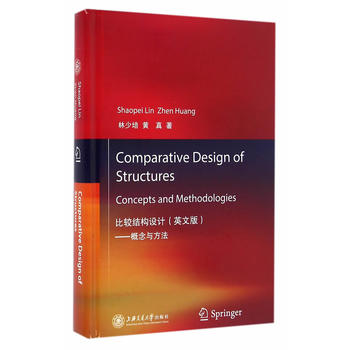
微信扫一扫,移动浏览光盘
简介
林少培、黄真*的《比较结构设计--概念与方法(英文版)》针对结构概念设计提出了比较设计的理念,重点表现合理化、可持续的结构性能。基本构件的机械特征通过3D结构进行展示,详细研究元素的组成与拆分,以便*好地理解如高层建筑、大跨通道和空间结构等多样化的结构。
目录
Chapter 1 Introduction of Design Philosophy1.1 The Essentials of Engineering Design1.2 The Concept of Comparative Design1.2.1 Design Space Theory1.2.2 The Fuzzy Expression of Pd1.3 From Empirical to Intelligent Design1.4 Functional Aspect of Design1.5 On Sustainable Development1.6 On Aesthetics in Design1.6.1 Principles in Consideration of Aesthetics1.6.2 National Characteristics in Aesthetics1.7 ConclusionsChapter 2 Introduction to Structural Design2.1 The Features of Modern Structures2.2 The Processes of Structural Design2.3 The Process of Architectural Design2.3.1 The Elements of Architectural Design2.3.2 The Relation Between Structure and Architecture2.3.3 The Process of Architectural Design2.3.4 The Application of Structural Concepts in Architectural Design2.4 The Structural Behavior and Design Principles2.4.1 The Structural Behavior and Energy Principle2.4.2 Overall Stability of Structure and Stability in Its Geometric Composition2.4.3 The Upper-and Lower-Bound Theorem in Limit Analysis of Structure2.4.4 Instability and Structural Dynamics2.4.5 Fundamental Principles of Structural Design2.5 The Loadings Analyses2.5.1 Vertical Load2.5.2 Wind Load2.5.3 Seismic Load2.5.4 Other Loads and Effects2.6 The Acting Loads and the Structural Deformation ResponseChapter 3 Global Design of Structures3.1 The Classification of Structural Systems3.2 Methods of Global Analysis of Structures3.3 Facade Allocation Analysis Through "Force Flow" Method3.4 Planar Layout Analysis Through "Footprint" Method3.5 External Configuration and Balancing Design of Structures3.6 Decomposition of Asymmetric Complex Structures3.7 Overall Structural Performance3.8 ConclusionsChapter 4 Systematic Analyses of Substructures4.1 Analyses of Structural Components4.1.1 Analysis of Horizontal Components4.1.2 Analysis of Vertical Components4.2 Analysis of Prestressed Structural Elements4.3 Structural Joints and Connections4.4 Decomposition of Structural Systems4.5 Integrated Structures and Substructures4.6 Characteristics and Simplified Analysis of HorizontalSubstructure Systems4.6.1 Characteristics of Horizontal Substructure Systems4.6.2 Simplified Analysis of Horizontal Substructure Systems4.7 Characteristics and Simplified Analysis of Vertical Substructure Systems4.7.1 Characteristics of Vertical Substructure Systems4.7.2 Classification and Simplified Calculation of Vertical Substructure Systems4.8 ConclusionsChapter 5 Comparative Design and Analyses of High-Rise Buildings5.1 Characteristics of High-Rise Structures5.1.1 General Characteristics5.1.2 Overall Analysis of Vertical Structures5.2 Design of Shear Wall Structures5.3 Design of Frame Structures5.4 Design of Tube Structures5.5 Design of Mixed Vertical Structures5.5.1 Skip-Floor Truss Structural System5.5.2 Giant Frame Structures5.5.3 Connecting-Tower Structural System5.5.4 Framed Tube Structural System5.5.5 Suspended Core-Tube Structural System5.5.6 Inclined Column Truss Structural System5.6 Comparative Analyses of Milestone High-Rise Buildings5.6.1 Outer Trussed Tube-in-Tube System in Shanghai World Financial Center5.6.2 The World Trade Center in New York, USA5.6.3 Beijing CCTV TowerChapter 6 Comparative Design and Analyses of Large-Span Structures6.1 Characteristics of Large-Span Structures6.2 Design for Arch Structural System6.3 Design for Suspension Cable Structural System6.4 Design for Cable-Stayed Structural System6.5 Comparative Analyses of Well-Known Large-Span Structures6.5.1 Shanghai Lupu Bridge6.5.2 Guangxi Nanning Bridge6.5.3 Jiangyin Yangtze River Bridge6.5.4 Gibraltar Strait Bridge6.6 ConclusionsChapter 7 Comparative Design and Analyses of Spatial Structures7.1 Characteristics of Spatial Structures7.2 Design for Spatial Truss and Grid Structural System7.3 Design for Latticed Shell Structural System7.4 Design for Membrane Structural System7.5 Design for Spatial Deployable Structural System7.6 Comparative Analyses of Sophisticated Spatial Structures7.6.1 Shanghai New International Expo Center7.6.2 Beijing National Center for the Performing Arts7.6.3 The Georgia Dome7.6.4 Kunming Peacock Art Square of World Garden ExpoChapter 8 Intelligent Design Based on Knowledge Engineering8.1 Introduction of Intelligent Design8.2 Fuzzy-AI Model Applied to Comparative Design8.2.1 The Fuzzy Expression of Pd8.2.2 Fuzzy Reasoning of the Intelligent Design8.2.3 How Fuzzy-AI Model Works in Intelligent Design?8.3 Mathematical Modeling of Design Space8.4 Fuzzy Mathematical Distance in Design Space8.4.1 Fuzzy Mathematical Distance by Membership Difference8.4.2 Fuzzy Mathematical Distance by Nearness Degree8.5 Fuzzy Reasoning and AI-Machine Learning Model8.5.1 AI-Machine Learning Model8.5.2 Machine Learning Modeling8.6 Neural Network Reasoning for Structural Design Parameters8.6.1 Neural Network (NN)8.6.2 Fuzzy Neural Network (Fuzzy-NN)8.6.3 Fuzzy-NN Architecture for Machine Learning8.6.4 Conclusive Remarks8.7 Fuzzy Neural Network Model for Structural Design8.7.1 Introduction8.7.2 Neural Network Back-Error Propagation Learning8.7.3 NN Machine Learning for Sample Classification8.7.4 The Implementation of Fuzzy Machine Learning8.7.5 Fuzzy-NN Machine Learning for Structural Design8.8 ConclusionsConclusionAppendix AAppendix BReferences
比较结构设计—概念与方法
- 名称
- 类型
- 大小
光盘服务联系方式: 020-38250260 客服QQ:4006604884
云图客服:
用户发送的提问,这种方式就需要有位在线客服来回答用户的问题,这种 就属于对话式的,问题是这种提问是否需要用户登录才能提问
Video Player
×
Audio Player
×
pdf Player
×


